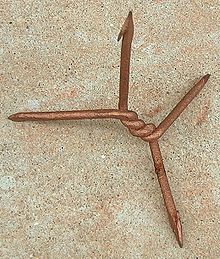Area denial weapon

| Part of a series on |
| War Outline |
|---|
 |
An area denial weapon is a defensive device used to prevent an adversary from occupying or traversing an area of land, sea or air. The specific method may not be totally effective in preventing passage, but is sufficient to severely restrict, slow down, or endanger the opponent. Some area denial weapons pose risks to civilians entering the area even long after combat has ended, and consequently are often controversial. An area denial weapon can be part of an anti-access/area denial (A2/AD) strategy.
Historical methods
Anti-cavalry
In medieval warfare, sturdy stakes were stuck into the ground at the bottom of long lines of ditches, positioned with a sharp end pointing up diagonally, in order to prevent cavalry charges in a given area. Even if the stakes were spotted, horsemen would be forced to dismount and effectively give up their advantage as cavalry, and become easier targets. The correct layout of these extensive lines of ditches and the control of stake size, form and placement were part of the craft of war.
An alternative cavalry deterrent, allowing quicker dispersal and providing the advantage of being hidden more easily, was the deployment of, for example, small balls with spikes, used during most of antiquity. Many variants were used, such as boards with metal hooks, as described as used by
Anti-infantry
Simple rows or clusters of sharpened sticks (nowadays also known as punji sticks), and small caltrops have been used in anti-infantry warfare since antiquity. However, due to the difficulty of mass-producing them in the pre-modern age, they were rarely used except in the defense of limited areas or chokepoints, especially during sieges, where they were used to help seal breaches. Increasing ease of production still did not prevent these methods from slowly falling out of favor from the late Middle Ages onward.[1]

Caltrops are still sometimes used in modern conflicts, such as during the Korean War, where Chinese troops, often wearing only light shoes, were particularly vulnerable.[1] In modern times, special caltrops are also sometimes used against wheeled vehicles with pneumatic tires. Some South American urban guerrillas such as the Tupamaros and Montoneros, who called them "miguelitos," have used caltrops to avoid pursuit after ambushes.[2]
Modern methods
Explosives
The most common area denial weapons are land mines of various types, planted by hand or dispersed by artillery. Some modern prototypes experiment with automatic guns or artillery-delivered ammunitions that are fired only after remote sensing detects enemies.
During an
156 states are parties to the Ottawa Treaty under which they have agreed not to use, stockpile, produce or transfer anti-personnel mines.
CBRNE agents
Various CBRNE (Chemical, Biological, Radiological, Nuclear, and Explosive) weapons can be used for area denial, as long as the agent is long-lasting.
Anthrax spores can contaminate the ground for long periods of time, thus providing a form of area denial.[3] However, the short-term (tactical) effects are likely to be low - the psychological effects on an opponent would likely be more significant.
The massive use of defoliants such as Agent Orange can be used as an interdiction measure because they leave areas empty of any form of vegetation cover. In the desert-like terrain that ensues, it is impossible for the enemy to travel without being seen, and there is little cover in case of an attack, especially from the air.
Many
Targeted
To address some of the problems with land-mines (see
Drawbacks
As area denial weapons do not discriminate between friend, foe, or civilian, they make the affected zone hazardous for all trying to enter. Concepts for area denial weapons which do discriminate (by active sensing) have often been proposed, but have not yet reached a stage of general usefulness, due to their high complexity (and cost) and the risk of misidentification.
Explosive-based area-denial weapons (mines) may be intentionally equipped with detonators which degrade over time, either exploding them or rendering them relatively harmless. Even in these cases, unexploded munitions often pose significant risk.
See also
- Active Denial System
- Anti-access/area denial
- Area Denial Artillery Munition
- Decontamination foam
- Denied area
- Scorched earth
- Sea denial
- Sentry gun
- Suppressive fire
References
- ^ Weider History Group.
August 1998
- ^ Jorge Zabalza historical leader from the MLN-Tupamaros urban guerrilla mentioned this use against official vehicles as a main tactic on book "0 from the left"
- ^ Iraqi Use of Biological Weapons (from the Federation of American Scientists homepage)
- ^ Successful Firing of Area Denial Weapon System (ADWS) by Defence Consortium Archived September 28, 2007, at the Wayback Machine (from the Metal Storm Limited homepage, Tuesday 12 July 2005)
External links
 Media related to Area denial weapons at Wikimedia Commons
Media related to Area denial weapons at Wikimedia Commons
